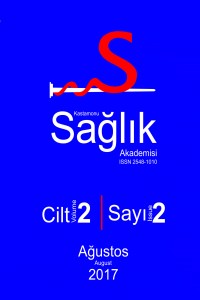ÖN BÖLGE İMPLANTLARININ HASTA BAŞI CAD-CAM KİŞİSEL SERAMİK ABUTMENTLARLA REHABİLİTASYONU: 2 OLGU SUNUMU
Öz
Kişisel
abutmentlar, anterior bölgeye uygulanan implant destekli protezlerde
karşılaşılacak bir çok problem çözmeye yardımcı olur. Kişisel abutmentların
üretiminde kullanılan tekniklerden biri de; zirkonya ve lityum disilikat
abutmentların üretimine olanak sağlayan CAD-CAM teknolojisinin kullanılmasıdır.
Bu vaka raporunda; anterior bölgede yetersiz mezio-distal genişliği bulunan 2
vakanın CAD-CAM teknolojisi ile tasarlanan kişisel seramik abutmentlar ile
tedavisi anlatılmaktadır. Her iki vakada da sol maksiller santral diş bölgesine
yerleştirilen implant, CAD-CAM sisteminde tasarlanan ve üretilen kişisel
abutmentlar ile restore edilmiştir. Abutmentlar, Vaka 1 için zirkonyadan ve
Vaka 2 için lityum disilikattan üretilmiştir. Daha sonra abutmentların üzerine
lityum disilikat kronlar yapılmıştır. 12 aylık takibin sonunda; her iki hasta
da protezlerinden memnun olduklarını belitmişlerdir. 5 ay sonunda Vaka 2’de
abutment vida gevşemesi görüldü fakat 12ay süresince başka bir komplikasyon
görülmedi.
Anahtar Kelimeler
Dental-implant abutment tasarımı lityum disilikat yttria stabilize tetragonal zirkonya
Kaynakça
- 1. Bertolini Mde M, Kempen J, Lourenco EJ, Telles Dde M. The use of CAD/CAM technology to fabricate a custom ceramic implant abutment: a clinical report. J Prosthet Dent 2014;111:362-6.
- 2. Bressan E, Paniz G, Lops D, Corazza B, Romeo E, Favero G. Influence of abutment material on the gingival color of implant-supported all-ceramic restorations: a prospective multicenter study. Clin Oral Implants Res 2011;22:631-7.
- 3. Karunagaran S, Paprocki GJ, Wicks R, Markose S. A review of implant abutments-abutment classification to aid prosthetic selection. J Tenn Dent Assoc 2013;93:18-23.
- 4. Misch CE. Screw-retained versus cement-retained implant-supported prostheses. Pract Periodontics Aesthet Dent 1995;7:15-8.
- 5. Alqahtani F, Flinton R. Postfatigue fracture resistance of modified prefabricated zirconia implant abutments. J Prosthet Dent 2014;112:299-305.
- 6. Kucey BK, Fraser DC. The Procera abutment--the fifth generation abutment for dental implants. J Can Dent Assoc 2000;66:445-9.
- 7. Sailer I, Zembic A, Jung RE, Siegenthaler D, Holderegger C, Hammerle CH. Randomized controlled clinical trial of customized zirconia and titanium implant abutments for canine and posterior single-tooth implant reconstructions: preliminary results at 1 year of function. Clin Oral Implants Res 2009;20:219-25.
- 8. Zembic A, Sailer I, Jung RE, Hammerle CH. Randomized-controlled clinical trial of customized zirconia and titanium implant abutments for single-tooth implants in canine and posterior regions: 3-year results. Clin Oral Implants Res 2009;20:802-8.
- 9. Mollersten L, Lockowandt P, Linden LA. Comparison of strength and failure mode of seven implant systems: an in vitro test. J Prosthet Dent 1997;78:582-91.
- 10. Norton MR. An in vitro evaluation of the strength of an internal conical interface compared to a butt joint interface in implant design. Clin Oral Implants Res 1997;8:290-8.
- 11. Sailer I, Sailer T, Stawarczyk B, Jung RE, Hammerle CH. In vitro study of the influence of the type of connection on the fracture load of zirconia abutments with internal and external implant-abutment connections. Int J Oral Maxillofac Implants 2009;24:850-8.
- 12. Chun H-J, Yeo I-S, Lee J-H, Kim S-K, Heo S-J, Koak J-Y, et al. Fracture strength study of internally connected zirconia abutments reinforced with titanium inserts. Int J Oral Maxillofac Implants 2015;30:346-50.
- 13. Adatia ND, Bayne SC, Cooper LF, Thompson JY. Fracture resistance of yttria‐stabilized zirconia dental implant abutments. J Prosthodont 2009;18:17-22. 14. Albosefi A, Finkelman M, Zandparsa R. An in vitro comparison of fracture load of zirconia custom abutments with internal connection and different angulations and thickness: Part I. J Prosthodont 2014;23:296-301.
- 15. Yilmaz B, Salaita LG, Seidt JD, McGlumphy EA, Clelland NL. Load to failure of different zirconia abutments for an internal hexagon implant. J Prosthet Dent 2015;114:373-7.
- 16. Klotz MW, Taylor TD, Goldberg AJ. Wear at the titanium-zirconia implant-abutment interface: a pilot study. Int J Oral Maxillofac Implants 2010;26:970-5. 17. Sailer I, Sailer T, Stawarczyk B, Jung RE, Hämmerle C. In vitro study of the influence of the type of connection on the fracture load of zirconia abutments with internal and external implant-abutment connections. Int J Oral Maxillofac Implants 2009;24:850-8.
- 18. Bankoğlu Güngör M, Yılmaz H, Karakoca Nemli S, Turhan Bal B, Aydın C. Effect of surface treatments on the biaxial flexural strength, phase transformation, and surface roughness of bilayered porcelain/zirconia dental ceramics. J Prosthet Dent 2015;113:585-5.
- 19. Karakoca S, Yılmaz H. Influence of surface treatments on surface roughness, phase transformation, and biaxial flexural strength of Y‐TZP ceramics. J Biomed Mater Res Part B: Appl Biomater 2009;91:930-7.
- 20. Asar NV, Çakırbay M. Zirkonya-rezin siman bağlantısını güçlendirmede kullanılan yüzey işlemleri. Acta Odontol Turc 2013;30:162-8.
Ayrıntılar
| Bölüm | Olgu sunumları |
|---|---|
| Yazarlar | |
| Yayımlanma Tarihi | 28 Ağustos 2017 |
| Gönderilme Tarihi | 4 Haziran 2017 |
| Kabul Tarihi | 1 Ağustos 2017 |
| Yayımlandığı Sayı | Yıl 2017 Cilt: 2 Sayı: 2 |
Sağlık Akademisi Kastamonu, 2017 yılından itibaren UAK doçentlik kriterlerine göre 1-b dergiler (SCI, SSCI, SCI-expanded, ESCI dışındaki uluslararası indekslerde taranan dergiler) sınıfında yer almaktadır. SAĞLIK AKADEMİSİ KASTAMONU Dergi kapağı Türk Patent Enstitüsü tarafından tescil edilmiştir.


